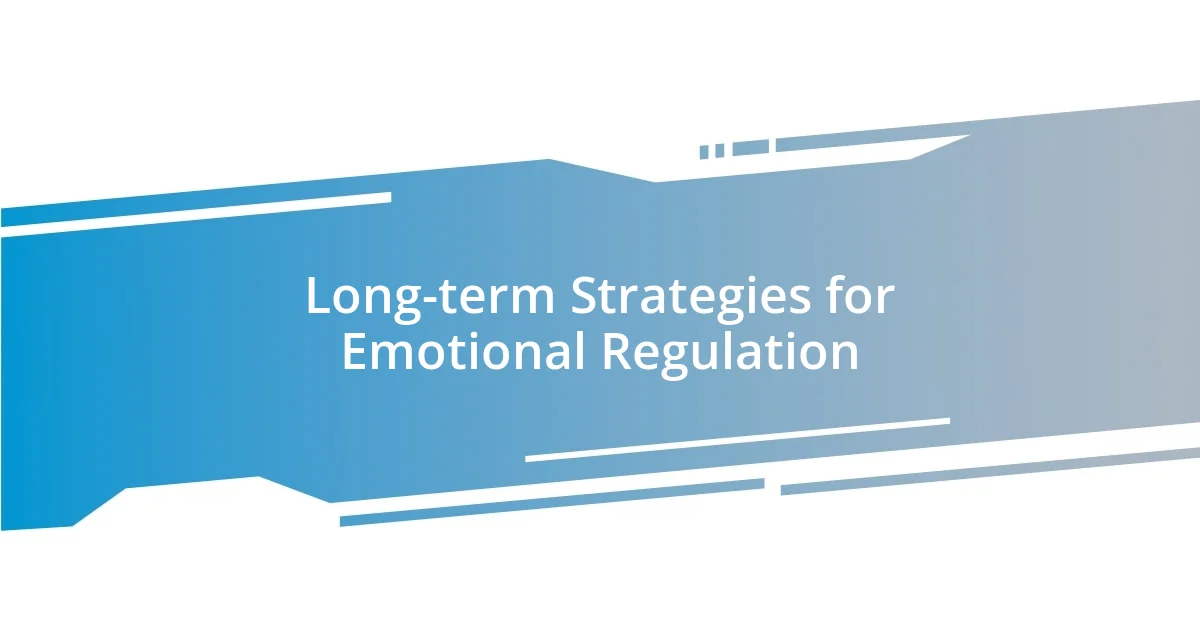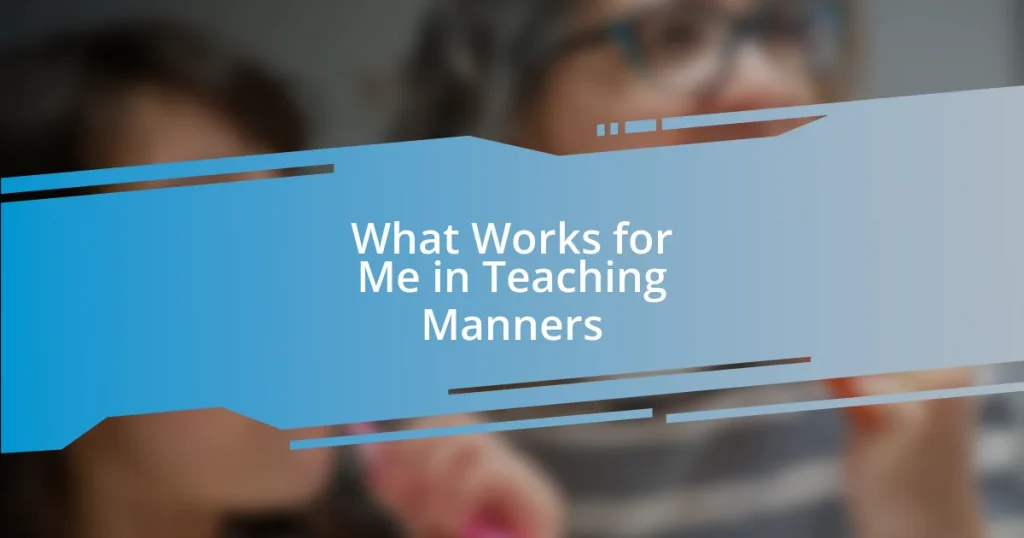Key takeaways:
- Toddler tantrums often arise from emotions that children can’t express verbally; understanding their feelings can foster compassionate responses.
- Identifying triggers such as fatigue, hunger, overstimulation, and transitions can help parents anticipate and mitigate tantrums.
- Implementing effective communication strategies and long-term emotional regulation techniques, like mindfulness and emotion check-ins, can nurture emotional intelligence in toddlers.

Understanding Toddler Tantrums
Toddler tantrums can feel like a rite of passage for both children and parents. I remember a particularly vivid afternoon when my little one threw an epic meltdown over not being able to wear his favorite shirt, which was in the wash. In those moments, it’s easy to feel overwhelmed, but I learned that these outbursts often stem from a complex mix of emotions and a lack of language skills to express them.
It’s fascinating to consider how toddlers experience life with such intensity. Their feelings are raw and immediate, making minor frustrations feel monumental. Reflecting on my own experiences, I often wondered, “What are they feeling right now?” Understanding that my child was feeling helpless or frustrated helped me respond with compassion instead of frustration.
From sleepless nights to minor inconveniences, tantrums often erupt from a child’s need to communicate their discomfort. I once found myself on the floor, eye-to-eye with my child, trying to grasp what was going on in his mind. We both had our moments of vulnerability—his unrestrained emotions and my concern for how to guide him through the storm. That’s when I truly realized that these tantrums were not just disruptions; they were opportunities for connection and understanding.

Identifying Triggers of Tantrums
Identifying the triggers of toddler tantrums can sometimes feel like solving an intricate puzzle. In my experience, I noticed patterns in my child’s behavior, particularly tied to hunger and fatigue. One evening, after skipping his nap, my little one turned into a whirlwind of frustration over a simple request to wash his hands. This overwhelming exhaustion led to an emotional outburst I could have anticipated had I tuned into his needs earlier.
It’s remarkable how environmental factors can also play a role. During a family grocery trip, the chaos of the store overwhelmed him, leading to a meltdown in the cereal aisle—a place bursting with colors and sounds. This taught me the importance of observing what’s around him; a noisy environment or too many choices could easily trigger his anxiety. Now, when we head out, I prepare him for what to expect, making our outings smoother.
I’ve also learned that transitions can be particularly challenging for toddlers. I remember one afternoon trying to get him to move from playtime to dinner; the moment felt like pulling him away from a world he loved. Recognizing this as a trigger, I now give him a small warning before transitions, helping him feel more secure and less likely to react with frustration. This simple strategy has transformed our routine, making those moments of change a bit easier for both of us.
| Trigger Type | Example Scenario |
|---|---|
| Fatigue | Tantrum after skipping a nap |
| Hunger | Meltdown due to being hungry before meals |
| Overstimulation | Outburst in crowded or noisy places |
| Transitions | Reaction when asked to switch activities |

Effective De-escalation Techniques
Effective de-escalation techniques can truly make a difference in handling toddler tantrums. I vividly recall a time when my child was screaming over a toy. In that moment, I knew that yelling back would only fuel the fire. Instead, I crouched down to his level, making eye contact and speaking softly. That simple gesture seemed to anchor him, calming the storm of emotions swirling around us. I learned that sometimes just being present and connected can defuse the situation.
Here are some effective de-escalation techniques I’ve found helpful:
- Calm Presence: Maintain a calm demeanor; your energy sets the tone.
- Validate Feelings: Acknowledge what your child is feeling. Saying, “I see you’re upset because you want that toy,” can help them feel understood.
- Distraction: Offer a different activity or toy to shift their focus.
- Change the Environment: If possible, take them to a quieter space to help soothe overwhelming emotions.
- Deep Breaths: Model deep breathing. I often take exaggerated, deep breaths myself, which my child imitates.
- Use a Visual Aid: Sometimes using a picture chart for emotions can help them identify and express what they feel.
Implementing these de-escalation techniques not only calms the immediate situation but also nurtures emotional intelligence in my child, something that I genuinely believe will benefit him as he grows. I cherish these moments of connection, as they teach both of us how to navigate emotions together, reinforcing our bond.

Establishing Consistent Routines
Establishing consistent routines has been a game changer in my household. I’ve found that predictable schedules create a sense of security and stability for my toddler. For instance, we have a set bedtime routine where we read a book, brush teeth, and then snuggle for a few minutes. These small rituals signal to my child that it’s time to wind down, making those nightly tantrums over bedtime less frequent.
Every morning, I noticed we were often rushing, leading to meltdowns as I scrambled to get us out the door. By implementing a morning routine that includes a wake-up song and a breakfast checklist, my child knows what to expect, which has significantly eased our mornings. Have you ever found yourself in the chaotic rush of a morning? That sense of direction can minimize anxiety and get the day off to a more restful start.
Mealtime routine has also been integral for our family dynamics. I realized when I started serving dinner at the same time every evening, my child felt less anxious and more ready to enjoy the meal. We even have a fun, simple chant to signal that dinner is ready, which makes him look forward to it and minimizes fussiness. What little routines have you built in your home to create harmony? These structured moments have transformed the way we engage and enjoy each other’s company, turning potential tantrum triggers into opportunities for connection.

Communicating with Your Toddler
Communicating with a toddler can sometimes feel like deciphering a secret code; their emotions are big, but their words are small. I remember one particularly challenging day when I was at my wits’ end, trying to understand why my little one was crying over a crayon. I knelt down and asked calmly, “Can you show me what’s bothering you?” Miraculously, it opened a floodgate of chatter about colors that I didn’t even know he was thinking about. It struck me then how valuable open-ended questions can be—they invite your toddler into a conversation and help them feel heard.
It’s fascinating to see how body language plays a prominent role in our communications. I’ve found that when I maintain a soft tone and use gestures to relate, my child becomes more engaged and less defensive. The other day, I mimicked the action of drawing to express excitement over something he was creating. The smile that spread across his face told me that he appreciated the effort. Have you tried matching your energy to your child’s? It’s a simple shift that fosters connection, making it easier for them to express what’s truly on their minds.
Another lesson I’ve learned is to embrace the power of patience during those emotional exchanges. When my toddler is upset, rather than rushing in with solutions, I often take a moment for myself. I’ve found that waiting a few seconds can help him articulate what he really needs. I once witnessed him transform from uncontrollable tears to a clear, “I want my blanket!” It made me realize that giving him that space allows for more genuine communication, building confidence not just in himself but in our relationship. How do you approach those moments of frustration? By nurturing those dialogue opportunities, we enrich our understanding of each other, which ultimately leads to calmer days ahead.

Long-term Strategies for Emotional Regulation
Long-term strategies for emotional regulation in toddlers often revolve around teaching them how to express and manage their feelings. I remember a time when my little one flipped out over a favorite toy being misplaced. Instead of rushing to fix it, I gently guided him to use words to express exactly how he felt. It was quite a moment when he finally said, “I’m sad!”—a breakthrough that never fails to remind me how essential it is to give children the tools for verbal expression. Have you experienced a similar moment with your child? These skills take time to develop, but every little step counts.
Incorporating mindfulness techniques into our day has also proved invaluable. I once introduced deep-breathing exercises during a particularly stressful nighttime routine. We sat cross-legged on the floor together, and I demonstrated taking slow, deep breaths in and out. Watching him mimic my movements was heartwarming—a tangible reminder that children can learn to self-soothe, too. This practice has become our go-to when we feel tensions rising. Do you think your little one might benefit from a similar approach?
Another powerful strategy is validating their emotions through “emotion check-ins.” I realized that simply pausing during a meltdown to say, “It’s okay to be upset; let’s talk about it,” created a safe space for my toddler to open up. Once, after a tantrum during playtime, I noticed he calmed down considerably after I acknowledged his feelings; it was as if a weight had been lifted. Have you tried checking in on your child’s emotions like this? It’s remarkable how these small gestures build empathy and emotional intelligence over time, shaping them into resilient little beings.

When to Seek Professional Help
Sometimes, it becomes clear that we’re not equipped to handle every situation on our own. I recall a moment when my toddler threw a tantrum not just from frustration but from what seemed like sheer helplessness, and I felt completely overwhelmed. It was around that time I learned that if tantrums are occurring consistently and are accompanied by behaviors like aggression, self-harm, or extreme distress, it might be a signal that seeking professional help could be beneficial. Have you ever felt that pang of uncertainty about your child’s emotions?
There’s a fine line between typical tantrums and something a bit deeper. I noticed my child’s behavior escalating, with frequent meltdowns lasting longer than usual. This made me wonder: could there be underlying developmental issues? Consulting with a pediatrician opened up a dialogue about child psychology strategies. I found it reassuring to know that getting an expert’s opinion doesn’t mean we’ve failed as parents; rather, it shows our commitment to understanding our child’s needs. Have you considered talking to someone when you feel out of your depth?
Trusting your instincts is vital. I remember how I hesitated for weeks before reaching out for advice, thinking I could handle it alone. But the moment I did, I felt a weight lift off my shoulders. Each professional consultation taught me new techniques to navigate those tough days. Seeing my toddler thrive after we incorporated expert-recommended strategies reinforced that seeking help can transform our family dynamic for the better. Don’t underestimate the power of support—it could be just what you and your little one need.
















